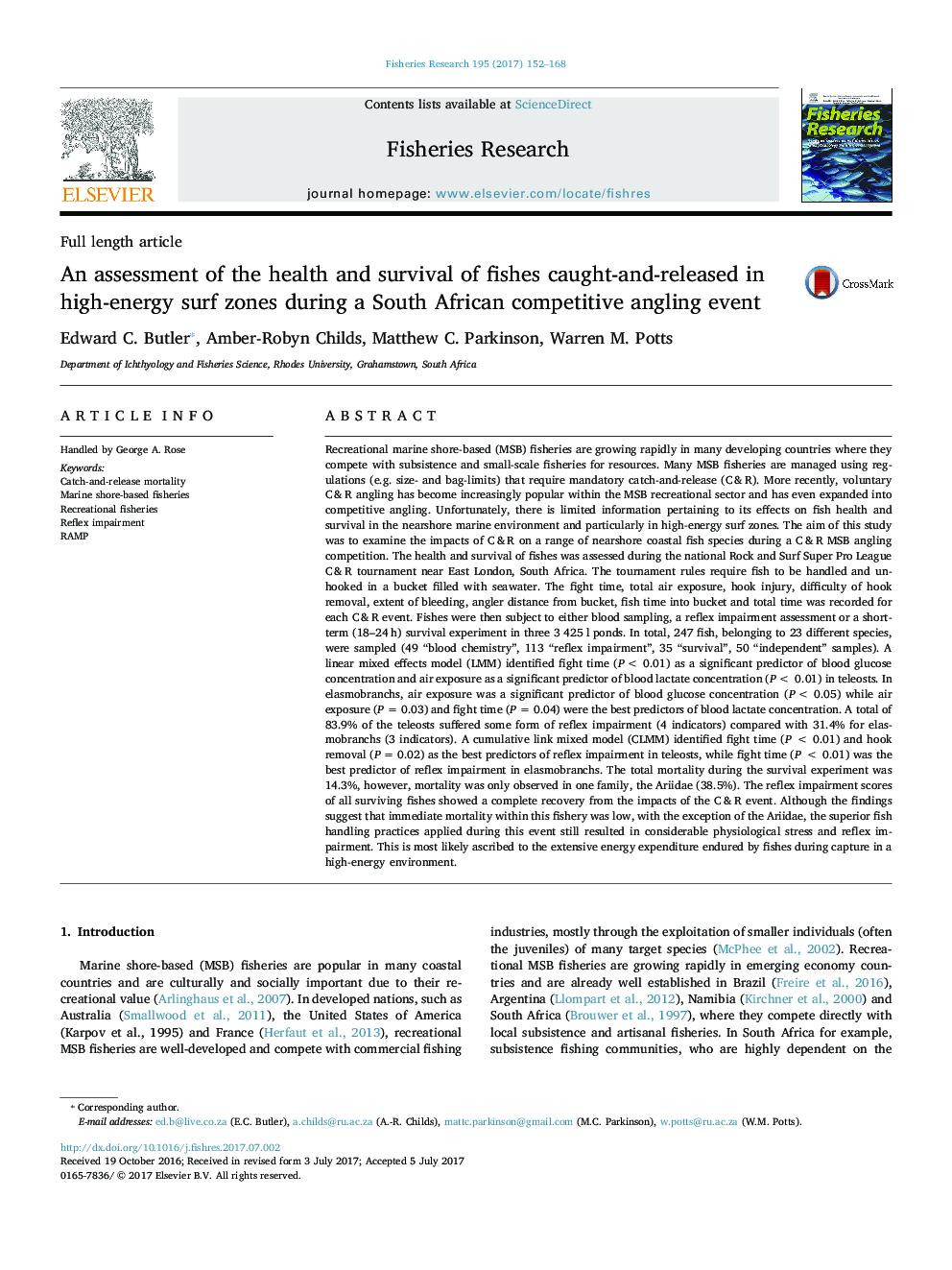| کد مقاله | کد نشریه | سال انتشار | مقاله انگلیسی | نسخه تمام متن |
|---|---|---|---|---|
| 5765513 | 1626775 | 2017 | 17 صفحه PDF | دانلود رایگان |
عنوان انگلیسی مقاله ISI
An assessment of the health and survival of fishes caught-and-released in high-energy surf zones during a South African competitive angling event
ترجمه فارسی عنوان
ارزیابی سلامتی و زنده ماندن ماهی هایی که در مناطق غرق شده در طول یک رویداد ماهیگیری رقابتی آفریقایی گرفتار و آزاد شده اند
دانلود مقاله + سفارش ترجمه
دانلود مقاله ISI انگلیسی
رایگان برای ایرانیان
موضوعات مرتبط
علوم زیستی و بیوفناوری
علوم کشاورزی و بیولوژیک
علوم آبزیان
چکیده انگلیسی
Recreational marine shore-based (MSB) fisheries are growing rapidly in many developing countries where they compete with subsistence and small-scale fisheries for resources. Many MSB fisheries are managed using regulations (e.g. size- and bag-limits) that require mandatory catch-and-release (C&R). More recently, voluntary C&R angling has become increasingly popular within the MSB recreational sector and has even expanded into competitive angling. Unfortunately, there is limited information pertaining to its effects on fish health and survival in the nearshore marine environment and particularly in high-energy surf zones. The aim of this study was to examine the impacts of C&R on a range of nearshore coastal fish species during a C&R MSB angling competition. The health and survival of fishes was assessed during the national Rock and Surf Super Pro League C&R tournament near East London, South Africa. The tournament rules require fish to be handled and unhooked in a bucket filled with seawater. The fight time, total air exposure, hook injury, difficulty of hook removal, extent of bleeding, angler distance from bucket, fish time into bucket and total time was recorded for each C&R event. Fishes were then subject to either blood sampling, a reflex impairment assessment or a short-term (18-24Â h) survival experiment in three 3 425Â l ponds. In total, 247 fish, belonging to 23 different species, were sampled (49 “blood chemistry”, 113 “reflex impairment”, 35 “survival”, 50 “independent” samples). A linear mixed effects model (LMM) identified fight time (P <Â 0.01) as a significant predictor of blood glucose concentration and air exposure as a significant predictor of blood lactate concentration (P <Â 0.01) in teleosts. In elasmobranchs, air exposure was a significant predictor of blood glucose concentration (P <Â 0.05) while air exposure (PÂ =Â 0.03) and fight time (PÂ =Â 0.04) were the best predictors of blood lactate concentration. A total of 83.9% of the teleosts suffered some form of reflex impairment (4 indicators) compared with 31.4% for elasmobranchs (3 indicators). A cumulative link mixed model (CLMM) identified fight time (PÂ <Â 0.01) and hook removal (PÂ =Â 0.02) as the best predictors of reflex impairment in teleosts, while fight time (PÂ <Â 0.01) was the best predictor of reflex impairment in elasmobranchs. The total mortality during the survival experiment was 14.3%, however, mortality was only observed in one family, the Ariidae (38.5%). The reflex impairment scores of all surviving fishes showed a complete recovery from the impacts of the C&R event. Although the findings suggest that immediate mortality within this fishery was low, with the exception of the Ariidae, the superior fish handling practices applied during this event still resulted in considerable physiological stress and reflex impairment. This is most likely ascribed to the extensive energy expenditure endured by fishes during capture in a high-energy environment.
ناشر
Database: Elsevier - ScienceDirect (ساینس دایرکت)
Journal: Fisheries Research - Volume 195, November 2017, Pages 152-168
Journal: Fisheries Research - Volume 195, November 2017, Pages 152-168
نویسندگان
Edward C. Butler, Amber-Robyn Childs, Matthew C. Parkinson, Warren M. Potts,
